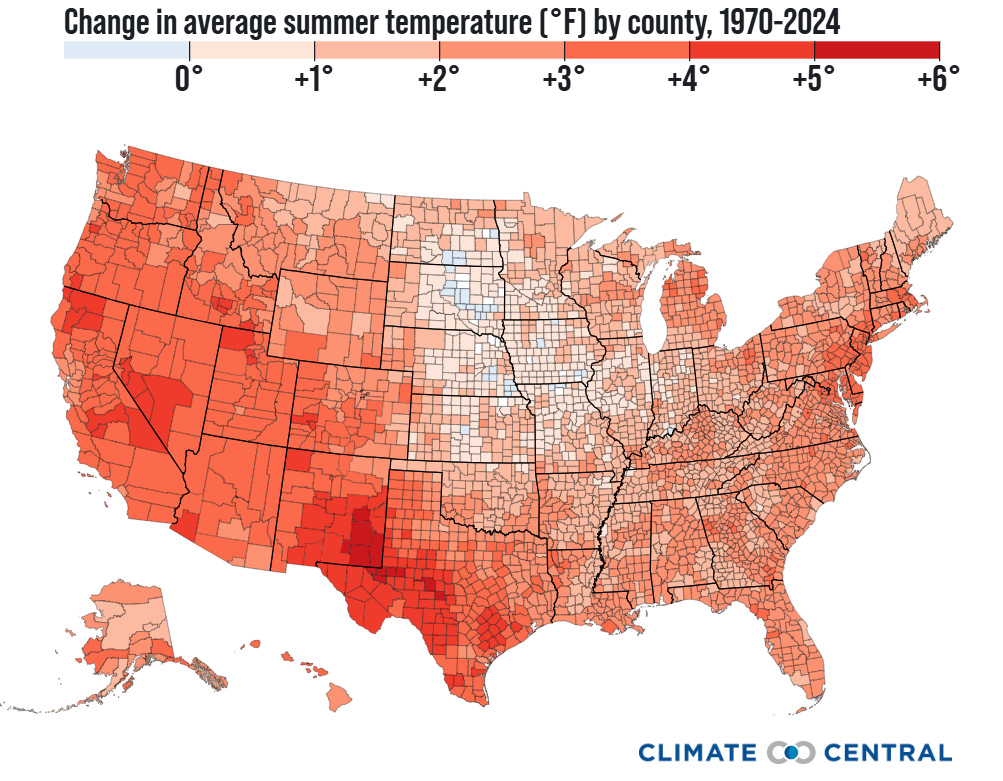𝗜𝘁’𝘀 𝗴𝗲𝘁𝘁𝗶𝗻𝗴 𝗵𝗼𝘁𝘁𝗲𝗿... 𝗘𝘅𝗰𝗲𝗽𝘁 𝘄𝗵𝗲𝗿𝗲 𝗶𝘁’𝘀 𝗴𝗲𝘁𝘁𝗶𝗻𝗴 𝗰𝗼𝗼𝗹𝗲𝗿.
𝗦𝘂𝗺𝗺𝗲𝗿𝘀 𝗵𝗮𝘃𝗲 𝘄𝗮𝗿𝗺𝗲𝗱 𝗶𝗻 𝟵𝟳% 𝗼𝗳 𝟮𝟰𝟮 𝗨.𝗦. 𝗰𝗶𝘁𝗶𝗲𝘀 analyzed — by an average of 𝟮.𝟲°𝗙 𝘀𝗶𝗻𝗰𝗲 𝟭𝟵𝟳𝟬 (check out the map from Climate Central below). The warming trend isn’t news.
But 𝟯% 𝗼𝗳 𝗰𝗶𝘁𝗶𝗲𝘀 𝘀𝗮𝘄 𝘁𝗲𝗺𝗽𝗲𝗿𝗮𝘁𝘂𝗿𝗲𝘀 𝗖𝗢𝗢𝗟𝗜𝗡𝗚 𝗼𝘃𝗲𝗿 𝘁𝗵𝗶𝘀 𝟱𝟱 𝘆𝗲𝗮𝗿 𝗽𝗲𝗿𝗶𝗼𝗱 might be.

The cooling trend shows up in the mid-west, in states like the Dakota’s, Nebraska, Kansas, Missouri and Iowa.
At the other extreme, 𝗮 𝗻𝘂𝗺𝗯𝗲𝗿 𝗼𝗳 𝗰𝗼𝘂𝗻𝘁𝗶𝗲𝘀 𝗵𝗮𝘃𝗲 𝘀𝗲𝗲𝗻 𝘁𝗲𝗺𝗽𝗲𝗿𝗮𝘁𝘂𝗿𝗲𝘀 𝗿𝗶𝘀𝗲 𝗯𝘆 𝟱°𝗙 𝗼𝗿 𝗺𝗼𝗿𝗲, notably in west Texas and New Mexico.
So what? For starters it is a good reminder of the variability of climate change. The impact, however, varies. A few examples:
• 𝗖𝗼𝗼𝗹𝗶𝗻𝗴 𝗗𝗲𝗺𝗮𝗻𝗱: Widespread warming drives electricity demand for AC, necessitating significant grid and renewable energy investments.
• 𝗟𝗼𝗰𝗮𝗹𝗶𝘇𝗲𝗱 𝗥𝗶𝘀𝗸: Investors must pinpoint regional climate risks; warming areas face higher asset vulnerability, while cooling spots present unique considerations.
• 𝗧𝗮𝗿𝗴𝗲𝘁𝗲𝗱 𝗥𝗲𝘀𝗶𝗹𝗶𝗲𝗻𝗰𝗲 𝗜𝗻𝘃𝗲𝘀𝘁𝗺𝗲𝗻𝘁: Capital must flow into tailored, heat-resilient infrastructure where temperatures spike, adapting strategies to specific regional climate shifts.

